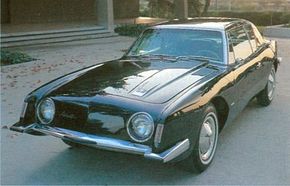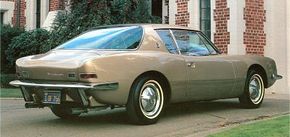While he had Milwaukee-based industrial designer Brooks Stevens working on emergency updates of the Lark and Hawk, Studebaker president Sherwood Egbert called in Raymond Loewy to design a new generation of Studebaker passenger cars. Loewy, who hadn't worked for Studebaker since 1956, jumped in with enthusiasm, promising Egbert a sporting coupe of revolutionary design, from which a complete line of family cars would evolve. Studebaker quit before the family cars were finished, but Loewy did give Egbert one brief shining moment with the memorable 1963-1964 Studebaker Avanti.
Designed in seclusion by Loewy's talented team of Bob Andrews, Tom Kellogg, and John Ebstein, the Avanti (the Italian word for "forward") was a styling sensation. A coke-bottle waist formed the base for a thin-section roof with a huge rear window and a built-in rollbar. Razor-edged front fenders swept back into the curved rear, then into a jacked-up tail. Loewy threw out the conventional grille, putting an air scoop under a thin front bumper, and an asymmetrical hump in the hood. Inside, ample crash padding was combined with four slim-section vinyl bucket seats and an aircraft-style control panel. The whole package was accepted for production with hardly any changes from Loewy's small-scale model.
Advertisement
For reasons of cost and time, Studebaker decided to build the Avanti's body out of fiberglass. It would need a stout platform, so chief engineer Gene Hardig took a beefy Lark convertible frame, shortened and modified it, and fitted anti-sway bars and rear radius rods. The Bendix disc brakes used on the Avanti (as well as some Larks and Hawks) were the first caliper discs in domestic production. The engine was the best V-8 Studebaker had, the faithful 289, which developed 240 bhp in standard ("R1") tune thanks to a 3/4 race high-lift cam, dual-breaker distributor, four-barrel carb, and dual exhausts.
Andy Granatelli and Paxton also developed a supercharged "R2" with 290 bhp, and a bored-out 304.5-cid version in three higher stages of tune: R3, R4, and R5. Only nine supercharged R3s were built (with a claimed 335 bhp), and the R4 (unsupercharged) and R5 were experimental. The latter had two Paxton superchargers, one for each cylinder bank, magneto ignition, and Bendix fuel injection. It developed an incredible 575 horsepower.
Go to the next page for more details on the 1963-1964 Studebaker Avanti.
For more information on cars, see:
- Classic Cars
- Muscle Cars
- Sports Cars
- Consumer Guide New Car Search
- Consumer Guide Used Car Search
Advertisement


